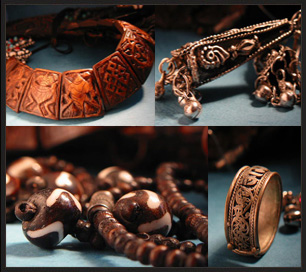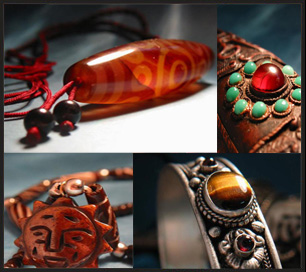|
Tibet Artwork, Tibetan Silver Jewelry , Tibetan Jewelry, Tibet Jewelry, Jewelry from Tibet, Tibetan Buddhist Jewelry, Tibetan Turquoise Jewelry, Tibetan Jewelery
Tibet Artwork, Tibetan Silver Jewelry , Tibetan Jewelry, Tibet Jewelry, Jewelry from Tibet, Tibetan Buddhist Jewelry, Tibetan Turquoise Jewelry, Tibetan Jewelery, Buddhist Jewelry
|
The color red is auspicious in Tibetan culture. It is a sacred color, one of the colors of the five Buddhas and the color of the monk's garments. It is believed to have protective qualities and is therefore often used to paint sacred buildings. In neighboring China, coral is a symbol of longevity, and in India it is thought to prevent hemorrhages. Hans Weihreter records beliefs about coral in western Tibetan cultures which center around blood. Coral is said to strengthen blood, and act beneficially for the menstruation of women.
The symbolism of the color red shines forth in Buddhist aesthetics in the type of paintings known as red thangkas. A style requiring high technical virtuosity, all elements making up these painting are subsumed in the overall red field characteristic of this special genre of thangka. Red is the color of powerful rituals and deeds. It is the color of passion, transmuted to discriminating wisdom. These are especially relevant in especially vigorous meditation rituals requiring equally potent meditative tools.
Another dimension regarding the color red is the belief surrounding coral, the semi-precious stone which is a gift from our mother ocean to remind us of our eternal foundation. It is actually composed of the skeletons of little animals into reef-plant - like with hard branches. It reminds us of our bones - hard and durable. Coral teaches us form, also flow and flexibility within form. It lives and breathes in the sea but its roots are anchored in the earth. It is one of the five sacred stones of the Tibetan Buddhists, and symbolizes the energy of life force.
Coral is believed to be a protection against the evil eye. In a curious belief it was supposed to lighten in color and become pale if the wearer were ill or even exposed to illness - or were given poison. The coral would then darken as the wearer recovered. The same attribute was associated with a woman's menstrual periods, which the coral was supposed to "share" with women. Coral was also associated with stopping the flow of blood from a wound, curing madness, imparting wisdom, and calming storms.
In Buddhism coral is believed to be generally good, and the Tibetans and Tibeto-Nepalese think of it as a good investment, and believe that the person who wears coral will have success in life.
|
Buddhist Symbols
In the earliest centuries of Buddhism, statues of the Buddha were not used. Instead, Buddhist art consisted of images symbolizing the Buddha and his teachings, such as the lotus, the Wheel of the Law, the Bodhi tree and the Buddha's footprints.
Eventually, the Buddha image became one of the most popular representations in Buddhism, but these early symbols remain important and are frequently used to this day. They are especially important in Theravada Buddhist countries like Sri Lanka and Thailand.
As Buddhism spread, Buddhist symbolism was enriched by the cultures it came into contact with. This is especially true of Buddhism in Tibet, which has developed a rich symbolic tradition. The central symbols of Tibetan Buddhism are the Eight Auspicious Symbols, known in Sanskrit as Ashtamangala (ashta meaning eight and mangala meaning auspicious). The Eight Auspicious Symbols are printed on Tibetan prayer flags, incorporated into mandalas and thangkas, and used in other forms of ritual art. Another important symbol is the Wheel of Life, a symbolic representation of the universe as understood by Tibetan Buddhists.
Other important types of symbolism in Buddhism include colors, especially the five colors of white, yellow, red, blue and green, and symbolic hand gestures called mudras. The articles in this section explore these Buddhist symbols, providing information on their history, meaning and use in Buddhism today. (For an introduction and quick guide to Buddhist colors, see our Chart of Buddhist Color Symbolism.)
|
|




添加新评论